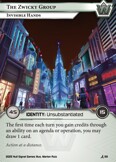The “Bioroids-matter” LEO Construction (🛰️) makes:
- any Bioroid ice (like Bumi 1.0) into a “purple Border Control”, and
- any Bioroid upgrades (like Mercia B4LL4RD) into a “local Bio Vault”.
Design
Bioroids with (hard)
↳ End the run.subs are, implicitly, like non-Bioroids with (soft)↳ End the run unless the Runner spends [click].subs. LEO complements Bioroids by “hardening” their EtR’s with a non-“bribeable” (as well as non-breakable) one.Despite being a repeatable EtR, LEO requires the heavy cost of a rezzed-sacrifice like ZATO City Grid (and unlike Nanisivik Grid or Sisyphus Protocol). This makes it more dynamic than Architects of Tomorrow (and much more than Stronger Together)*.
Cards
Bioroids (Upgrade/ICE):
- Mercia B4LL4RD: a
2[$] Upgrade, which installs ice clicklessly (to set up another “LEO’ing”), and does so with a triggered—not static—ability (to be sacrificed after already installing one or two ice). - Bumi 1.0: a
3[$] ICE, with an On-Rez (albeit worse than Magnet, and not EtR like Border Control). - Brân 1.0 and Ansel 1.0 (they're good).
See s:bioroid t:upgrade|ice z:standard (sorted by cost)
(Even more than M.I.C., a reprinted Eli 1.0 in LEO would've truly been the “HB–BC”.)
Non-Bioroid synergies:
- Harder Servers: like M.I.C. and Manegarm Skunkworks.
- Recursion: especially
Archives→server, like Ablative Barrier and over-advanced Project Ingatan (but also justArchives→HQ, like Corporate Hospitality?) - Compression: like Mercia (and Warm Reception or Tucana?))
Notes
Shred can prevent its EtR (unless they give up a card in hand in addition to the one in play). CF. Light the Fire!, which can blank upgrades like Manegarm Skunkworks, but not identities like LEO.
This card spoiled the new
Once per turn → …keyword-flag. IMO, it's: clearer than NSG's old templating (… Use this ability only once per turn.), being the first thing you read; and cleaner than the FFG's templating one (Once per turn, …), the extra comma being messy (uncapitalizing the non-boilerplate). Some card games keyword all common conditions (Once per turn: …,Enters: …, and so on).
Flavor
- The conceit (AFAICT) is that servers in space are harder to breach. While digital hacking should be comparable (the light-delay is still less than a second, unlike the second to the Moon and the minutes to Mars), any physical hacking becomes difficult (like planting listening devices, breaking into employees' offices, etc). IDK why the Octoroids get sacrificed. (LMK what you think.)
- A near-Earth hub or Earth station should be within a low-Earth orbit (Wikipedia) . Yet mechanically, LEO’s verticality is completely opposite to NEH’s / ES’s horizontality (which is cool).
Custom
BTW, the ID's aforementioned “complementarity” is a great design for any “TYPE-matters” build-around. (That is, cards of type “X” are consistently complemented by some effect “Y”, where X's can't provide you with Y and/or need some mitigation from Y.) Compare with:
a “Uniques-matter” ID: that can somehow make use of redundant copies of installed/rezzed
(◆)-cards. (maybe by “expend’ing” them from HQ, kinda like Angelique Garza Correa). or,a “Bad-Pub-matters” ID; that can sacrifice
Illicitsto somehow neutralizebad publicity(by removing it, preventing bad-pub from being spent, or so on).
Development
Bounty Hunters and Bioroids in Elevation Playtesting (Chronologist) :
A potential issue with LEO Construction was how it might constrict the design space of new bioroids. Safer compared it to NBN: Reality Plus, an identity that did not initially seem to restrict the design space of tags, yet due to its strength and flexibility turned out to be suffocating.
It is an abnormal HB identity, one that asks players to continuously reevaluate the worth of their bioroids. It is a glacier identity, yet not one that is likely to build servers tall enough to infringe on your opponent’s playmat every game.
With only four bioroid ice left in the new cardpool before Elevation, and an identity this dependent on access to bioroids, it was difficult to get the full sense of the potential power level of LEO Construction. And so, the developers offered up a unique bounty for playtesters: “Playtest LEO Construction, using all bioroids ever printed (except Fairchild 3.0)”. This gave a controlled environment that would simulate how LEO would operate in a future scenario with many more bioroids than exist today, allowing potential power level issues and future design space constrictions to be spotted during testing.
[…] Watzlav: “I was also hesitant [to trash my ice] at first, but then once I tried it, I realized it’s just an emotional thing. Like, Brân is the best piece of ice on the board right now. I can’t use it [for LEO’s ability]. But then if you just compare it with an M.I.C. or Border Control, M.I.C. is literally the same amount of money for a worse effect.”
[…] It’s late in the game. Safer has a Brân on R&D. The Runner goes in for a single access. “[I knew] I should use the Brân. [But] I was like… ‘it’s a single from R&D. It doesn’t matter. It’s fine…’ But I was pretty confident the ‘correct play’ was to stop the single access. And then they hit an agenda, and played Reprise and the game was lost from there.”
that's a cool take!
— D4v1d-Gr43b3rHere's what I think. LEO looks to be headquartered in space, and the description on the back of the card supports this (they specialize in low-grav workers, the Otto line of bioroids). So what I think happens is they hit a big red button, all current server activity gets routed into a single bioroid brain, and then the bioroid gets shot out into space. Then they reboot the server.
— lp87




My take on the flavour is they can quickly boot up a bunch of copies of a Bioroid to block access to their servers, but it costs them the one they copy. And the copies don’t last very long. But they don’t care because they can keep churning them out.
— Ksym777